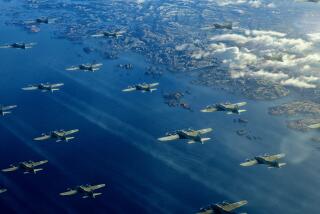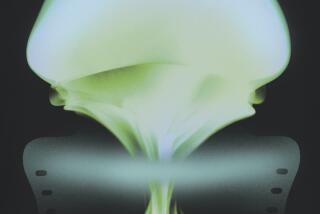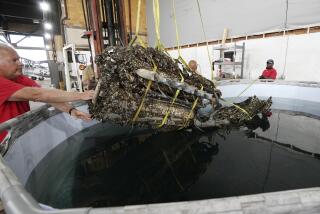Gen. Jimmy Doolittle Dies; War Hero, Aviation Pioneer : Flight: The celebrated ace, who grew up on the L.A. streets, was 96. He led daring 1942 Tokyo bombing raid.
- Share via
Gen. James H. (Jimmy) Doolittle, the tough Los Angeles street kid who rose to become one of the great figures in world aviation and a World War II air hero of epic stature, died Monday at the home of his son, John P. Doolittle, in Pebble Beach, Calif. He was 96.
The celebrated flying ace had suffered a stroke several weeks ago, said his daughter-in-law, Priscilla Doolittle.
Doolittle was best known as the daring leader of the bombing raid on Tokyo in 1942, the first significant American success against the Japanese during World War II. He was awarded the Medal of Honor for that mission, which historians have credited with pushing the Japanese Navy prematurely into its disastrous attack on Midway, a defeat said to be a turning point in the Pacific war.
Although rightly celebrated as military pilot and inspirational battle leader--he wound up as commanding general of the immense U.S. 8th Air Force in Europe--Doolittle may have contributed even more as a pioneer test pilot who was one of the first to make the transition from seat-of-the-pants daredevil to scientific flier.
Doolittle already was a famous flier when the virtually unknown Charles A. Lindbergh made his sensational solo flight across the Atlantic to Paris in 1927, and many believe his contributions to aviation matched or even surpassed those of the more famous “Lone Eagle.” Doolittle had become the first man to fly across the United States in less than 24 hours five years before Lindbergh became the first to make the transatlantic crossing.
In 1928 Doolittle became the first pilot to perform an outside loop, and a year later the first to “fly blind”--take off, fly a set course and land his plane all without seeing the ground. His feat was the beginning of instrument flying.
As Carroll V. Glines, one of Doolittle’s biographers, noted: “The 15- minute flight that early September morning marked the end of the ‘seat of the pants’ era of aviation. . . . Jimmy Doolittle had pushed back the frontier of flying another notch.”
Born in Alameda, Calif., on Dec. 14, 1896, he was the son of Frank Doolittle, a carpenter and a dreamer whose ancestors settled in New England in the 1600s, and Rosa Shepard Doolittle, a strong-willed woman whose practicality counterbalanced the impulsiveness of her adventurous husband.
The elder Doolittle had set out to make his fortune as a gold prospector in the Alaskan Klondike in 1897, failed to strike it rich, but still decided to bring his wife and son to the rugged frontier three years later when he moved to Nome. Doolittle went to grammar school, began to tinker with tools and machinery and learned to fight in Nome, which he said many years later was such a tough town that thieves sometimes stole whole houses.
In 1908 Doolittle’s parents separated. Young Doolittle moved with his mother to Los Angeles, and his father remained in Alaska.
Two years later Doolittle entered Manual Arts High School, becoming a classmate of two other Los Angeles kids who would go on to earn fame in other fields--film director Frank Capra and singer Lawrence Tibbett. It also was in 1910 that he witnessed an event that changed his life forever--the great air meet at Dominguez Field, the first ever held in the United States.
Among other heroics the 13-year-old Doolittle gawked at were Glenn Curtiss breaking the world’s speed record for aircraft, whizzing along at 55 m.p.h., and Louis Paulhan setting a world altitude record, a then dizzying 4,165 feet.
Two years after the aviation meet, Doolittle built his own aircraft, a wood-and-fabric glider along the lines of the present day hang-glider. He took a running jump off a cliff, and promptly crashed his glider, the first of at least a half dozen crashes he would survive over the years. Typically, he repaired the glider--and crashed it again.
During the same period, the pugnacious youngster--arrested at least once for brawling in the streets--was earning a reputation as an outstanding boxer. He was quick and tough enough to win the 105-pound (flyweight) amateur championship of the West Coast.
It was at Manual Arts that Doolittle met and fell in love with Josephine (Joe) Daniels, whom he married in 1917. They would become the parents of two sons. She died Christmas Eve, 1988, on the couple’s 71st wedding anniversary.
Doolittle attended Los Angeles Junior College , entered the UC Berkeley in 1916 to study mining engineering, but dropped out in 1917 to enlist in the Aviation Section of the U.S. Army Signal Corps.
He wanted to be a pursuit pilot, but he was such an instinctively gifted flier that after winning his wings he was made a flight instructor. He never got overseas during the First World War.
As a student pilot--he soloed after seven hours--and later as an instructor, Doolittle combined incredible skills with whimsical derring-do. He wrecked several airplanes attempting impossible stunts. He walked on the wings of Jenny biplanes, and once sat on the cross bar of a plane’s landing gear while another pilot brought the ship in for a landing.
He led an Army stunt team in air shows over Southern California and won rhapsodic praise from the Los Angeles Times: “The antics and evolutions of the five stunt men increased until finally the skies cleared and the acrobats held the center of the heavens alone, supreme in the mad glory of their thrilling feats.”
Once, according to Doolittle biographers Lowell Thomas and Edward Jablonsky, the aviator crashed a training plane while pursuing a brace of ducks. “It was then customary,” Doolittle explained later, “to combat with a duck. You would get on his tail and he’d turn and you’d turn--it was practice in an airplane because an airplane couldn’t fly much faster than a duck.” Doolittle escaped, as usual, without injury. The fate of the ducks was not recorded.
Doolittle chose to stay in the Army after the war, and quickly earned the reputation as one of the nation’s top pilots. Between 1918 and 1930, Doolittle set speed and distance records almost routinely. He also studied, taking his BA at Berkeley in 1922, his MS at the Massachusetts Institute of Technology in 1924, and his doctorate at MIT a year later--one of the first doctorates awarded in aeronautics.
One of his more celebrated achievements was winning the coveted Schneider Cup seaplane race in 1925, flying a Curtiss R3C-2 land plane which had been converted into a pontoon seaplane. He won the international competition with a world record speed of 232.5 m.p.h over the closed course.
In 1930, Doolittle resigned his Army commission because of what he called his “advanced age.” He was 34.
Commissioned as major in the Officers Reserve Corps, he maintained his close connection with military aviation, often testing new aircraft for the Air Corps, while at the same time working as pilot and manager of the aviation department of Shell Oil Co.
In 1932, Doolittle won the Thompson Trophy at the National Air Races in Cleveland, piloting a barrel-shaped Gee Bee R-1, its engine streaming dense smoke the whole way, to establish a pylon racing speed record of 258 m.p.h. At the same event, in the same almost uncontrollable stub-winged plane, he also set a world land speed record--296 m.p.h.
It was immediately after his victories in the Gee Bee--dubbed the “flying death trap” because it was so fast, unstable and overpowered--that Doolittle decided to retire from air racing. “We’ve learned a lot about engines and airplanes through racing,” Doolittle said at the time, “but it has been at great cost in lives and equipment. I think the time has come to give attention to safety and reliability.”
And in the ensuing years, at least until just before the outbreak of World War II, he devoted himself to developing reliability and safety in the air.
Doolittle returned to active duty in the Air Corps in 1940. When the Japanese attacked Pearl Harbor on Dec. 7, 1941, he was an aircraft production trouble-shooter in Detroit, and shortly after that was called to Washington to join the staff of Air Corps Chief of Staff Gen. Henry H. (Hap) Arnold.
On Dec. 21, 1941, President Franklin D. Roosevelt ordered an air raid on the Japanese mainland as soon as possible. The idea of flying overloaded Army bombers off the deck of an aircraft carrier to bomb Tokyo--then considered an almost insane thought--was conceived by Navy Capt. Francis Low. Doolittle was chosen to select the aircraft and crews and train them for the mission impossible.
Although Gen. Arnold had assigned Doolittle to training the Japan Raiders, he did not want him to lead the near suicidal mission.
“When we were about halfway through training, I asked Gen. Arnold if I might personally lead the mission,” Doolittle recalled in a 1982 interview with The Times. “He said, ‘No, I want you here on my staff.’ He apparently saw the disappointment on my face because the he said, ‘Well, if Biff Harmon (Arnold’s chief aide) has no objection, I have no objection.’ So I saluted and ran as fast as I could to Harmon’s office.”
Arnold had intended to call Harmon on the intercom and tell him that he really did not want Doolittle to fly the mission.
“But I got to Harmon’s office before the call and he said, ‘I have no objection if Gen. Arnold has no objection.’ So I said, ‘Thank you very much, sir.’ And I saluted briskly. I was just going out when I heard the squawk box, and Harmon saying, ‘But Hap, I just told him he could go.’ ”
The raid was carried out April 18, 1942.
Doolittle was the first pilot to lift his B-25 bomber off the deck of the carrier Hornet and the first to drop his bombs on Tokyo.
Although the raid did only minor damage to the Japanese mainland, it did incalculable damage to Japanese morale. More important, perhaps, it also boosted American spirits at a time when it was most needed.
But Doolittle initially thought the raid was a complete failure. Because the carrier had been spotted by Japanese picket ships, the 16 bombers were forced to take off earlier than anticipated--and none of the raiders reached the airfields in China where they were supposed to land. One flew to Soviet territory, where the crew was interned. The rest either crash-landed or bailed out in Japanese-occupied China. Of the 80 crewmen on the mission, seven died--including three captured and executed by the Japanese and one who starved to death in prison camp--and five were interned in the Soviet Union.
Doolittle and his crew bailed out. Unhurt but terribly depressed, Doolittle expressed his sense of failure to his crew chief, Sgt. Paul Leonard. “You know what’s going to happen to you?” Leonard asked Doolittle.
“Well,” Doolittle replied, “I suppose I’ll be thrown into Leavenworth military prison.”
“Nope,” Leonard said, “You’re going to be promoted to general officer. Then you’re going to get the Congressional Medal of Honor. And when we get back , you are going to have another airplane, and when you do I’ll be your mechanic.” On April 26, Doolittle was promoted to brigadier general. On May 19, he was presented the Medal of Honor by President Roosevelt.
Leonard did become Doolittle’s chief mechanic later in North Africa--only to be killed by a direct hit by a Nazi bomb in 1943. Doolittle himself found what remained of Leonard’s body. He said Leonard’s death was his worst personal loss of the war.
Doolittle became one of the top air commanders of World War II, at various times heading the 12th, 15th and 8th Air Forces.
The responsibility was weighty, and it sometimes bore down heavily on Doolittle. In 1944 he wrote his wife:
“I sometimes think that when this is all over I’d like to run a peanut stand. Would want it on a quiet street where there wouldn’t be too many customers to interfere with my meditations. Actually, after a week’s rest I imagine I’d be restless and looking for work and responsibility again.”
And he did seek out responsibility right away after the war, becoming a vice president and director of Shell Oil Co., serving on a host of government advisory committees and keeping current with the latest developments in aviation. In 1959, he became chairman of the board of Space Technology Laboratories Inc. and continued in that job until 1963.
In the ‘60s, he took on a number of other business responsibilities, including directorships of Thompson Ramo Woolridge, Mutual of Omaha Insurance and United Benefit Life Insurance, and chairmanship of the executive committee of Aerospace Corp.
Doolittle, after piloting virtually every aircraft produced in this country over a period of more than 40 years, from Jennys of wire and canvas to supersonic jets, gave up active flying in 1961.
In the 1982 interview, the old pro flier, a master of dry-witted irony, told this story on himself:
“I was in Des Moines, I guess it was six months ago, and the Air Force Reserve base had just gotten a flight simulator trainer, and they asked me if I’d like to ‘fly’ it. The first thing I did was to ‘fly’ it ‘straight into the ground.’ I wasn’t able to use the instruments that I’d helped to develop a few decades ago. The kids just got a tremendous laugh out of that.”
In the same interview, Doolittle had some comments on subjects he knew, perhaps, as well as any man--risk taking and the pursuit of excellence.
On the first: “I can honestly say that I have never felt fear, the kind you read about where you either lose control of yourself or you are shocked to a point where you don’t react properly. I’ve been in many tight situations, but there’s never been any fear. But I have made a very careful effort to solve the situation as quickly as possible and get out of the difficulty.”
On the second: “I believe in excellence, and I believe in reward for excellence. . . . I’ve tried all my life to do things as well as I could do them, sometimes successfully. Sometimes I’ve failed. . . . There have been disappointments, and successes, and successes are what you enjoy most, but the disappointments may be what you learn most from, because you analyze what happened and you are better prepared to cope the next time.”


